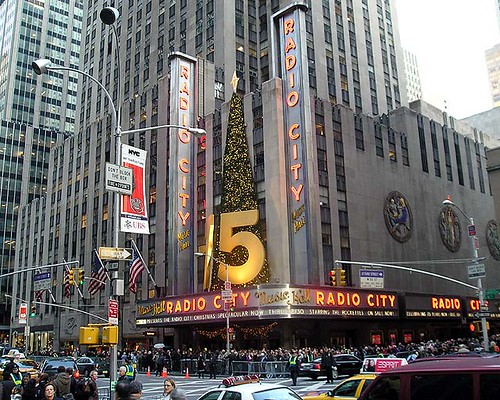
As we approach the Christmas season, what can be more festive than an afternoon with the Radio City Music Hall Rockettes and their Christmas Spectacular show?
All I can say is "wow."
What's more exciting, this is the 75th anniversary of the very first annual Christmas show, so I think they made it a little extra-special spectacular this year. It must be exhausting to be a Rockette, since they do a minimum of three shows a day to as many as five, from mid-November through New Years. I'm sure they must be double cast, but still, dancing more than one 90-minute show per day, every day, would be a challenge!
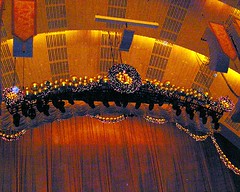
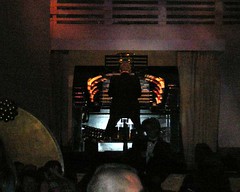
The show is in the beautiful and spectacular Radio City Music Hall, a gem of American Modernist architecture from the 1930s. The stage is huge at over 100 feet wide, there are three balconies, and the auditorium is said to be the largest indoor theater in the world, seating a little over 6,000. And, Ian and my seats were perfect Wednesday afternoon, just a little to the left of center in the middle of the orchestra seating, giving us wonderful views of the full stage.
Before and after the show, organists at huge organ consoles along the side walls flanking the stage played duet holiday music on the enormous "Mighty Wurlitzer" theater organ. I was kind of amused to see the organists' shoes spiked with bands of rhinestones to catch the spotlights as they played and moved their feet.
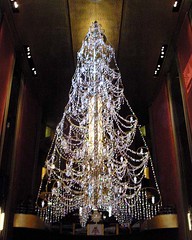 There's a beautiful, three-story-tall, crystal Christmas tree in the soaring lobby of the music hall, and there are all kinds of souvenirs for the show and for the Rockettes. They sold cocktails with glowstick stirrers, and I was surprised that they allowed drinks and food in the auditorium (especially those $10 little bags of cotton candy being sold to the kids—who'll clean up the mess?).
There's a beautiful, three-story-tall, crystal Christmas tree in the soaring lobby of the music hall, and there are all kinds of souvenirs for the show and for the Rockettes. They sold cocktails with glowstick stirrers, and I was surprised that they allowed drinks and food in the auditorium (especially those $10 little bags of cotton candy being sold to the kids—who'll clean up the mess?).But, on to the show! I wish I could have taken some pictures for you, but photography was prohibited, of course. Plus, there was no way to adequately capture everything that was happening to give you any kind of idea of the great pageantry and the scale or scope of this event.
They opened with the Rockettes dressed as reindeer at the North Pole, ultimately doing their signature kickline. Throughout the show, the precision and perfectly, perfectly straight dance lines of the Rockettes just astounded me. Even the military marching in formation doesn't get lines like these.
After we meet Santa Claus, he decides to go to New York City and instructs the audience to put on their 3-D glasses to come along for the voyage. A special screen drops down over the front of the stage, and we all go on a special effects animated tour across the tundra, through the skies, and up and down the narrow streets of New York with all the amazement and wonder that 3-D can bring!
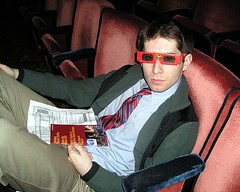 The show is a series of a dozen "scenes" starring the Rockettes and with a cast of singer-actors to help maintain continuity while the dancers change costumes and prepare for the next scene. Some of the scenes were absolutely magical. We got a holiday tour of downtown Manhattan with the Rockettes on a real double-decker bus that drove around the stage and with an actual ice skating rink and skaters that came up from the stage traps. There was an abridged version of The Nutcracker with a young girl ballerina as Clara, and her magical nutcrackers and characters were all danced en pointe by bears, including some pandas for the Chinese dance and a particularly large and divaesque bear as the Sugar Plum Fairy. The parade of the wooden soldiers marched forth (this was only the 74th year for them!). There's a nativity scene with a couple of live camels and a donkey and a flown angel with big, flapping wings.
The show is a series of a dozen "scenes" starring the Rockettes and with a cast of singer-actors to help maintain continuity while the dancers change costumes and prepare for the next scene. Some of the scenes were absolutely magical. We got a holiday tour of downtown Manhattan with the Rockettes on a real double-decker bus that drove around the stage and with an actual ice skating rink and skaters that came up from the stage traps. There was an abridged version of The Nutcracker with a young girl ballerina as Clara, and her magical nutcrackers and characters were all danced en pointe by bears, including some pandas for the Chinese dance and a particularly large and divaesque bear as the Sugar Plum Fairy. The parade of the wooden soldiers marched forth (this was only the 74th year for them!). There's a nativity scene with a couple of live camels and a donkey and a flown angel with big, flapping wings.One of the most amazing technical accomplishments of this show happened to be the backdrops for each of the scenes. There was one for the whole show: an enormous high definition flat panel television screen! The colors just popped from that HD TV and it allowed for all kinds of animation and film special effects. They did a lot of lighting and projection, too, making use of the entire auditorium and the walls and ceilings of the auditorium. Also, at one point, when Santa is demonstrating his magic to convince a skeptical fourteen-year-old that he really exists, he makes it snow on stage.....well, I've done enough shows to know how the stagehands do stage snow.....but this Santa was especially magic, because not only did he make it snow on stage, he made it snow out in the house! Several snowflakes hit me, and they were real snow!
The Radio City Music Hall Rockettes Christmas Spectacular is an American treasure. I wish everyone could make the pilgrimage to New York at least once in their lifetime to see this show—it's well worth the trip!

